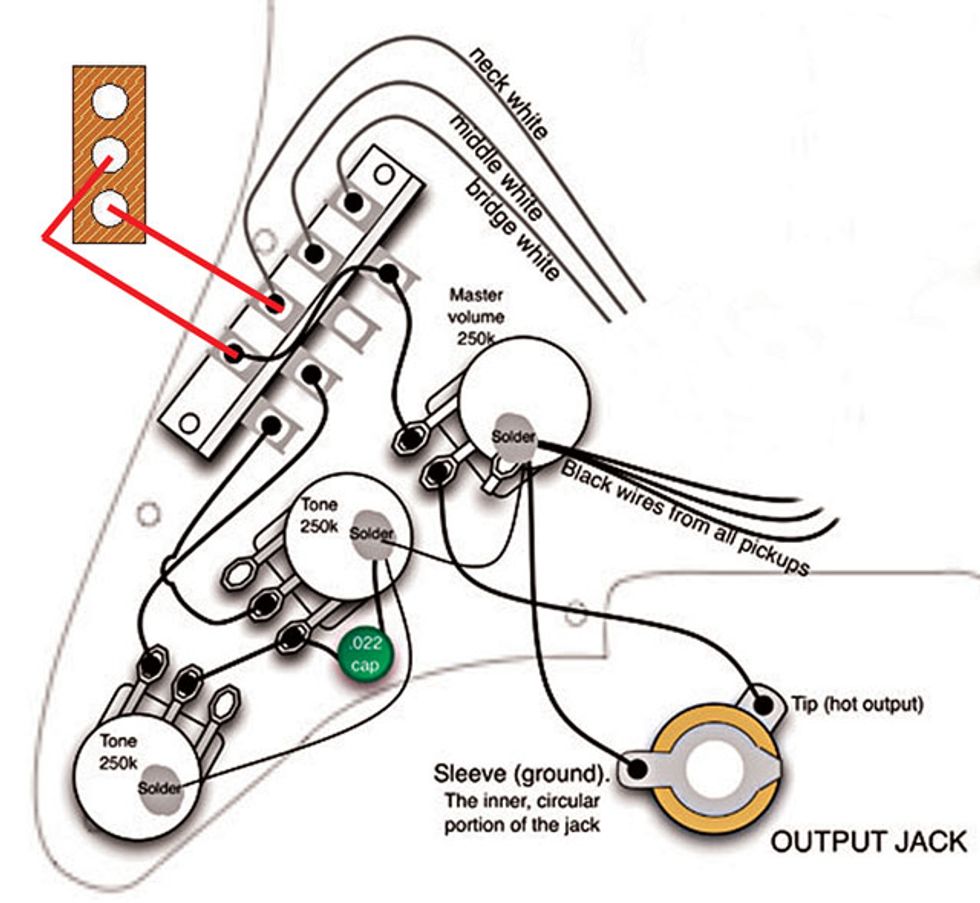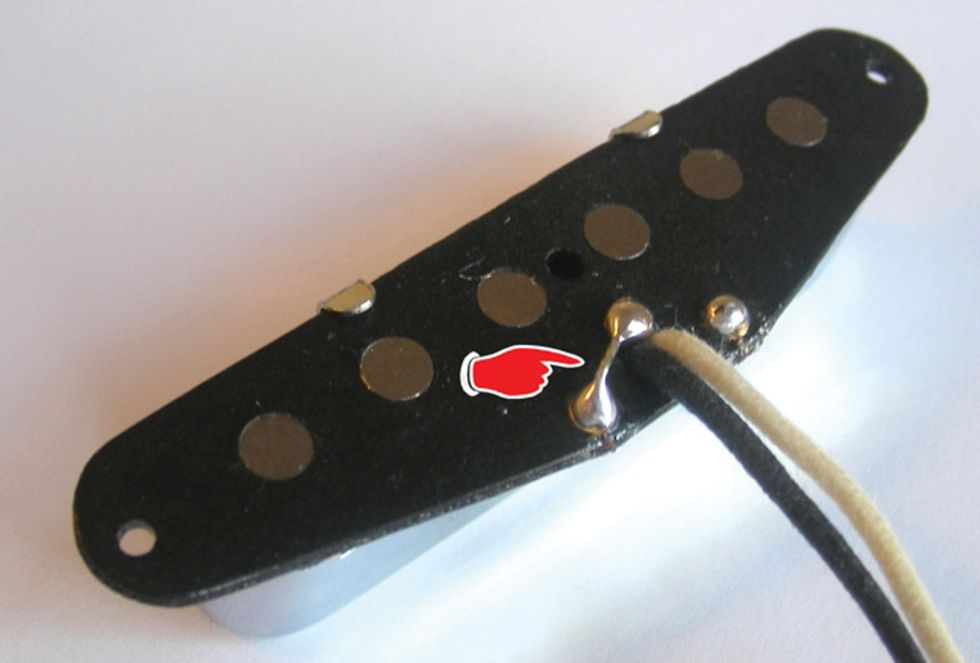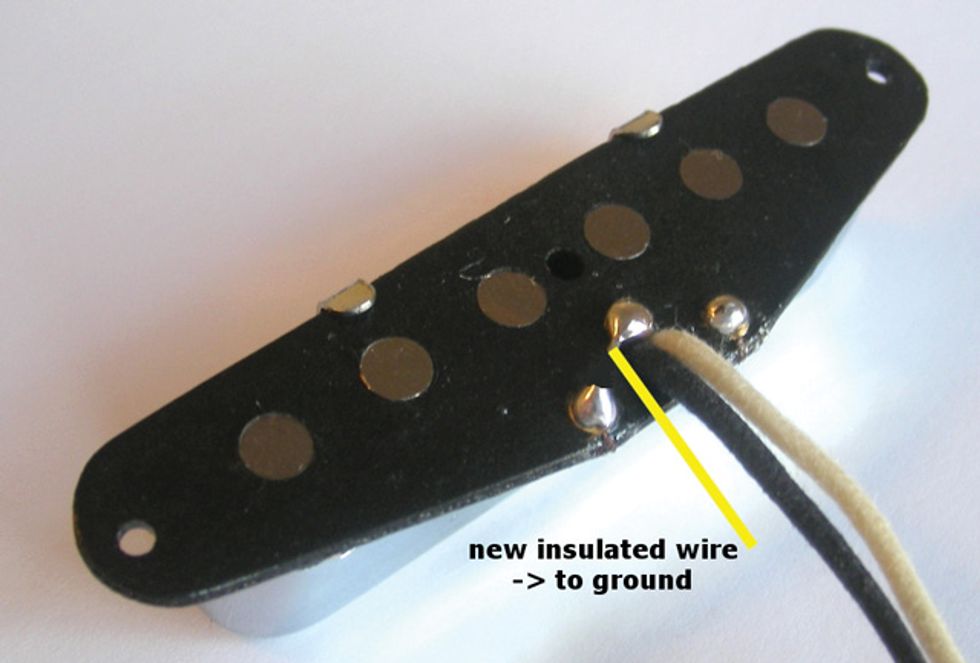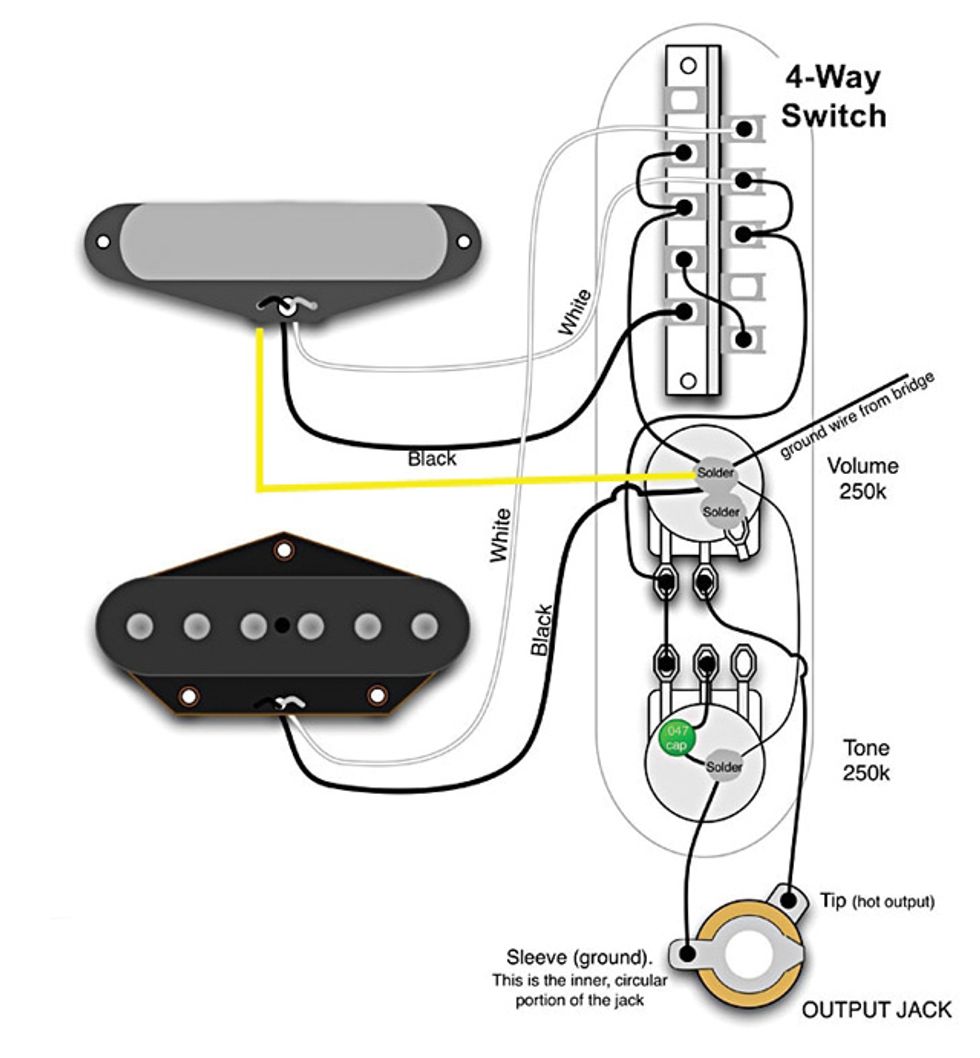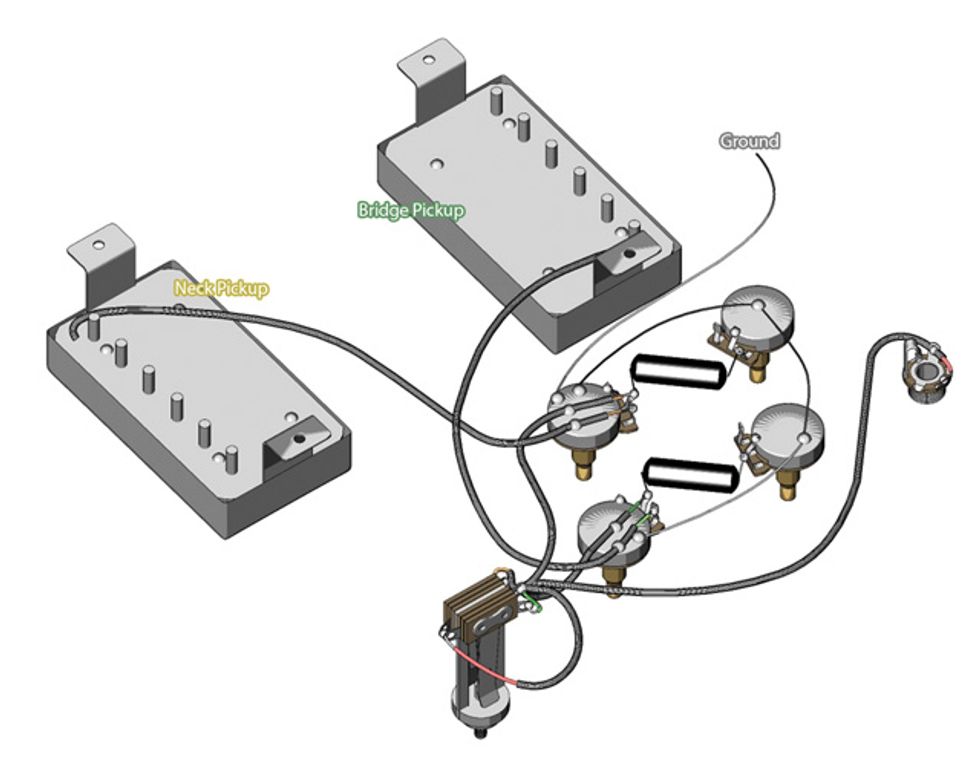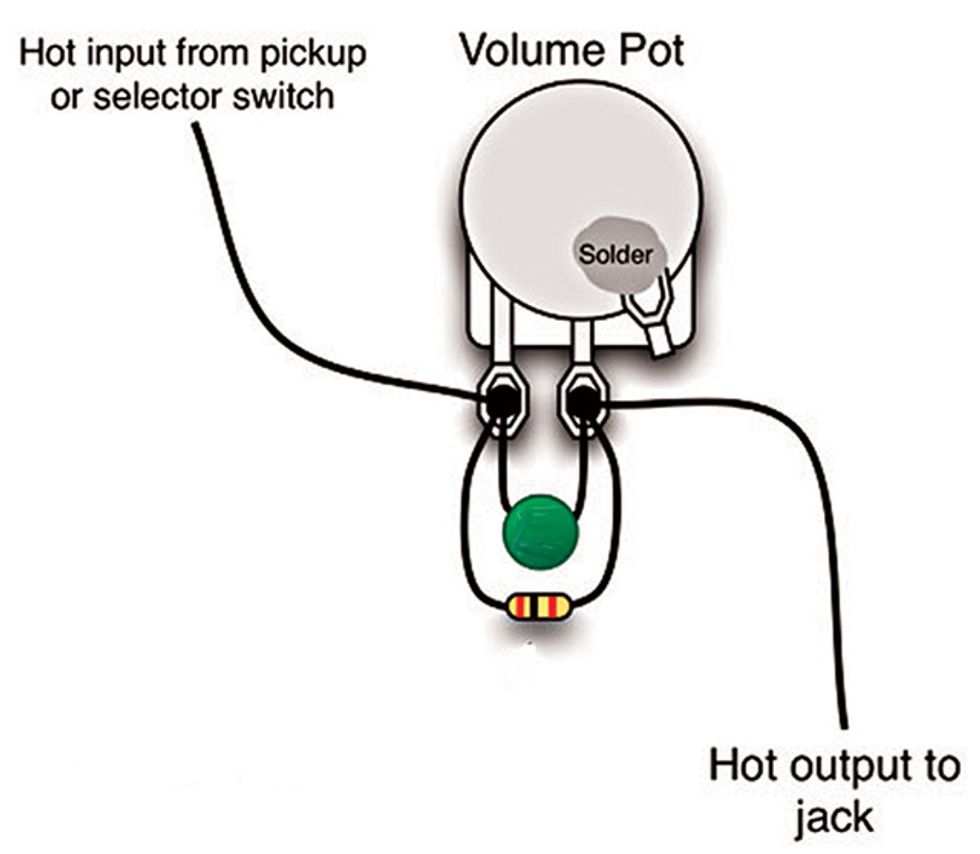Hello and welcome to this expanded take on my usual Mod Garage madness. Here we're going to tackle my favorite mods for the four most common electric guitars—the Fender Stratocaster and Telecaster, the Gibson Les Paul, and hard-rock- and metal-friendly “super strats" of various makes.
Although I've got tons of ideas for great-sounding mods that can be fairly complex (just check out my past Mod Garage columns on premierguitar.com), I believe small, simple mods like the ones here can make a huge difference in the number and quality of tones at your disposal. The other benefit of easy mods is that they introduce those who might be anxious about messing with their beloved guitars to the exhilarating world of modding and give them the confidence to try even more adventurous, fun, and rewarding mods in the future.
So let's get started. We'll begin with Leo Fender's second classic design—the Strat.
The 7-Sound Stratocaster
One of the most popular wiring projects for Stratocasters is also one of the oldest, so nobody can tell exactly who came up with it first. Some say it was invented by famous Western swing guitarist Eldon Shamblin, other sources say it was another swing guitarist named Bill Carson—who just happened to be Leo´s favorite guitar test pilot.
Regardless of its origin, this mod aims to rectify the one bummer that greedy tweakers see in the Strat's otherwise super flexible 5-position switch: With three pickups onboard, that means there are actually seven possible pickup combinations on a Strat. But standard wiring doesn't let you pair the bridge and neck pickups (like on a Telecaster) or all three pickups at the same time.
Standard Fender Stratocaster 5-Way Wiring
| Position | Pickup Combination |
| 1 | Bridge pickup only |
| 2 | Bridge and middle pickups in parallel |
| 3 | Middle pickup alone |
| 4 | Middle and neck pickups in parallel |
Thankfully, the 5-way selectors from companies like CRL or OakGrigsby (both of which are now owned by Electroswitch) make it easy to mod your Strat so that it still gets the factory-set combinations but also lets you add in the other two using an additional switch to engage the neck pickup. Several styles of switches can facilitate this, but they all have one thing in common—they're all a single-pole, single-throw (SPST) switch. In other words, they're all simple on/off switches.
You can install your new neck-pickup on/off switch by simply drilling a hole in your Strat's pickguard and installing a small SPST toggle, or you can replace one of the potentiometers with a push/pull or push/push pot with an integrated switch that lets you activate the neck pickup. Once you've done so, position 1 on your 5-way selector will still engage the bridge pickup alone, but when you flip your new toggle switch it will engage the neck pickup, too—so you'll have both in parallel. Same goes for position 2: It will still activate the bridge and middle pickups, but when you now engage the toggle you'll add the neck pickup, too.
7-Sound Stratocaster Mod Wiring
| Position | Pickup Combination | With SPST Switch Engaged |
| 1 | Bridge pickup only | Bridge and neck in parallel |
| 2 | Bridge and middle pickups in parallel | All three pickups in parallel |
| 3 | Middle pickup alone | Middle pickup only |
| 4 | Middle and neck pickups in parallel | Middle and neck in parallel |
| 5 | Neck pickup only | Neck pickup only |
Another cool way to perform this mod is to use a new pickguard outfitted with three SPST on/off switches instead of a 5-way switch. (Fender used this method for the Elite Stratocaster that was available from 1983 to 1984 by using three small on/off pushbuttons rather than the more common toggles.) While some feel the three-SPST approach can make it easier to keep track of which pickups are active at a single glance, the disadvantage is that it often takes more up and/or down motions than a typical 5-way switch to select a new pickup combination.
As for the usefulness of these new combinations, all three pickups together can provide a nice rhythm sound in certain settings, while the neck-and-bridge combo reminds me of the middle setting on a Telecaster—but a lot fatter and more defined.
Wiring diagram for the 7-sound Strat mod. Diagram courtesy of Seymour Duncan Pickups.
The 4-Way Telecaster
A marvelous mod for any standard-wired Telecaster is one in which you replace its stock 3-way switch with a special 4-way switch that, in addition to the standard middle-position parallel wiring of both pickups, lets you use the two pickups in series—a combination that yields a fat, loud tone that's great for leads.
This mod should not be confused with parallel/series humbucker switching. This is all about wiring two pickups, regardless of their type, together. On most guitars with more than one pickup, you can choose to play any one pickup by itself or through combinations of the pickups. The standard way to connect multiple pickups is to wire them in parallel—it's the industry standard because most people think it sounds more transparent and clear. It's the tone our ears know from countless records (e.g., positions 2 and 4 on a standard Strat). Only a few stock guitars use series-wired pickups, the most popular examples being the Brian May “Red Special" and most Danelectros.
So if series wiring is so uncommon, why should you try it? There are a lot of good reasons. First, if you want more volume and midrange out of your pickups, series switching may be perfect for you. Series-wiring two pickups together produces a longer path with increased resistance, which boosts volume and prevents the highest frequencies from getting through, while allowing more bass and midrange to pass through the circuit. It's great for driving a tube amp on the verge of overdrive into saturation without the help of an external booster. With series wiring, the output of one pickup goes into the input of another pickup, whereas with standard parallel wiring, each pickup takes its own path to the output. Because of this, series wiring has no effect on your tone when only one pickup is selected. In other words, single-pickup settings on two otherwise identical guitars—one with parallel wiring, one with series—will sound the same.
The reason you lose treble with series-wired pickups is because the long pickup wire works like a resistor. The longer the wire, the higher the resistance, which saps treble frequencies more than midrange and bass frequencies—just like with a long guitar cable. That means series-wired guitars are left with more prominent low end and midrange.
So now you know why series wiring produces a different tone, but why is it louder? Simply put, when you wire two pickups in parallel, each pickup loses a whopping three-quarters of its output. Essentially, you're adding two pickups operating at 25 percent output together, and you end up with a total output of about 50 percent. However, if you wire the same pickups in series, you'll add the outputs of two pickups operating at full volume. The result is a much louder sound. That said, this doesn't mean two pickups wired in parallel are half as loud as a single pickup, nor does it mean the two pickups wired in series are twice as loud as one pickup. Why? I don´t want to bore you to death with scientific explanations, but suffice it to say that it has to do with how the output level of your guitar translates to actual volume, the logarithmic nature of decibels (the unit of measure for volume), and the technicalities of how the human ear perceives them.
Let's move on to the details of setting up your Tele with the 4-way option. The first step is to unground and reground one of the pickups—preferably the neck unit. A typical Telecaster neck pickup has a metal cover, and one of its mounting tabs (which is folded under the coil) usually has a short jumper wire soldered to an eyelet on the pickup chassis (Photo 1).
A typical, metal-covered Telecaster neck pickup has a short grounding wire on the underside of its chassis.
This wire connects the coil to the negative wire. To unground and reground the cover, carefully clip the little jumper (Photo 2) and add a new insulated wire connecting the cover's tab to a ground point in the control cavity (e.g., the back of a pot). Be sure to insulate your new solder joint with some tape or heat-shrink tubing to avoid having it make unwanted connections with other components.
After you've cut the neck pickup's stock ground wire, solder a new insulated ground wire connecting the pickup (at the point indicated by the yellow line) to a ground point in the guitar's control cavity.
After you've regrounded your neck pickup with the new jumper wire, you're ready to grab your new 4-way switch and start soldering.
Wiring diagram for the 4-way Tele mod. Diagram courtesy of Seymour Duncan Pickups.
The Vintage-Wired Les Paul
My favorite mod for a Gibson Les Paul, SG, or ES-335—or any other double-humbucker guitar with master volume and tone knobs for each pickup—is also sometimes called “'50s wiring," “vintage wiring," or “'50s vintage wiring." But it all means the same thing: This mod makes your dual-humbucker Gibson operate the way they did back in the nifty '50s. Many players with PAF or PAF-style humbuckers prefer it because it yields many of the tones heard on iconic albums by so many guitar legends. (That said, you can also apply this mod to Strats, Teles, or any other type of guitar.)
If you spend much time in online guitar forums, you may already know that this mod has been a bit of a hot topic in recent years. Because of that, there are a lot of myths and urban legends about it.
Electronically, there's nothing too special about this wiring: It simply connects the tone pot to the output (the middle lug) of the volume pot instead of to the input. Tonally, however, '50s wiring has three major influences on your tone: First, your overall tone gets stronger and more transparent—more in your face. Some players say it “blooms," because the notes just seem to open up after you've played them. It's difficult to get this type of response from a dual-humbucker guitar without using this wiring style.
The second big impact that the vintage-wiring mod has is that it drastically decreases the treble attenuation that occurs when you roll back a volume knob. With passive volume controls, when you turn down—even just a little—the treble loss is far greater than the volume loss. One way to remedy this by installing a “treble-bleed" network—a combination of a capacitor and a resistor in parallel or in series—on your volume pots. However, '50s wiring does the trick, too. This means it's much easier to clean up an overdriven amp by simply rolling back the volume on your guitar. (Incidentally, we'll cover the treble-bleed mod next—it's my favorite for “super strats.")
The third big effect of this mod is that it makes your guitar's tone and the volume controls interact more than before, similar to how some Fender tube amps' EQ and volume settings alter responsiveness (e.g., when you change the volume, the tone changes a little bit as well and vice versa). This may feel strange at first, but it doesn't take long to adjust to it. Further, you'll also notice that your guitar's tone controls react much more smoothly and evenly, without the typical hot spots.
One of the other cool things about this mod is that it's not only easy, but it's also “invisible"—you don't have to alter how you switch pickups or add any new switches that complicate the layout of your switches and knobs. It's also easy to switch back to standard wiring.
Wiring diagram for the vintage-wired Les Paul mod. Diagram courtesy of Gibson Guitar Corp.
The “Super Strat" Treble Bleed
The term “super strat" originated in the '80s when fans of shredding guitar started outfitting stock Fender Strats with a humbucker or two (often with toggles for tapping or splitting the coils) and a double-locking tremolo like those from Kahler and Floyd Rose. Ibanez is perhaps the most successful of the companies that caught on to the trend and made it the foundation of its unique line, but today the term “super strat" is used more broadly to refer to just about any brand of double-cutaway guitar that sports an abuse-proof vibrato system and electronics that offer a variety of single-coil and humbucker sounds.
Given this heritage, it goes without saying that these guitars are often already equipped with circuits far more elaborate than the classic axes we've been discussing up to this point. But there's still one area in which many of them can still be improved. That's where our fourth fab project—the treble-bleed mod—comes in.
“Super strats" are often used with heavy distortion, but unless they've got active electronics, as soon as you turn down their volume knob(s) to get a cleaner tone, the sound gets muddy and less defined. As previously described, this is because a good portion of the high-end content is bled to ground.
So what is a treble-bleed network and what does it do? In layman's terms, it´s a combination of a small capacitor and a resistor wired in parallel (there are also variations with a cap only or a resistor in series with a cap). Techies sometimes call it an “RC network" (the “RC" referring to the resistor and capacitor), a "high-pass filter," or a “treble-bypass filter." The theory behind this simple circuit is much more complicated than it looks, so I'll break it down the simplest way I can. As a rule of thumb, the circuit's brightness is determined by the resistor's value (i.e., a lower ohm rating translates to more treble), but the frequencies that are present are determined by the cap´s value (i.e., the lower the value, the higher the frequencies, and the higher the value the lower the frequencies).
When you roll down the volume in a treble-bled circuit, it begins filtering out bass frequencies, thus making the trebles more prominent. To be clear, it doesn't boost trebles—a passive circuit can only selectively attenuate. But with a little trial and error, you can fine-tune your circuit's component values in order to filter out the specific frequencies that are muddying your signal when you turn down. And the result can be just as effective—if not more so—than a boost, because it lifts the metaphorical wooly carpet from off your signal without boosting a handful of frequencies out of the context of an overall band mix.
Given the huge range of variables in the rest of your “super strat's" circuit—from pot values to pickup magnets and output ratings—it's almost impossible to specify which capacitors and resistors will work best for your project (never mind what the rest of your signal chain looks like). But a good starting point is to get some small caps—say, from 220 pF up to 1200 pF—and resistors—from 100k ? up to 330k ?—and start experimenting to find out what works best for your guitar, your rig, and your musical preferences.
The easiest way to experiment and find the optimum capacitor and resistor values is to solder two wires to the input and output of the volume pot, and then connect an alligator clip to each of the free ends. This way you can let the two wires hang out from the control compartment for fast access. Try a bunch of different cap and resistor values, and when you've found your favorite combination, solder it into the circuit permanently and remove the two test wires. Then your shred machine will be an even more versatile and great-sounding guitar, no matter how much distortion you've got it going through!
Wiring diagram for the “super strat" treble-bleed mod. Diagram courtesy of Seymour Duncan Pickups.
It's a Mod, Mod, Mod, Mod World
Whether you're new to modding or an old hand at it, remember that it's not always the complicated mods that sound the best. Simple mods—those here, and many others—can drastically enhance your guitar's tones. So give these a try, and then be brave and solder along to new ones, too. And if you're not already checking out my monthly Mod Garage column, be sure to join us there each month. Until then, keep on modding!

